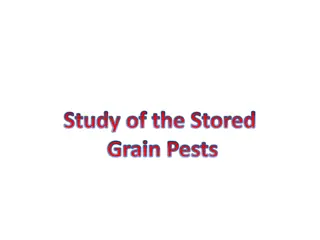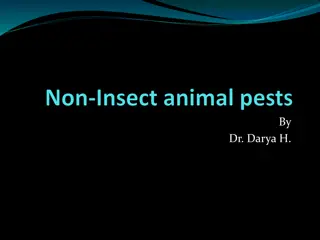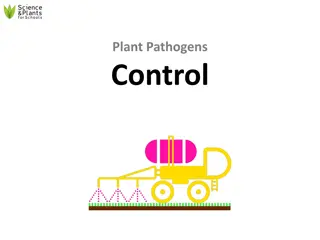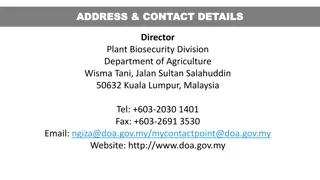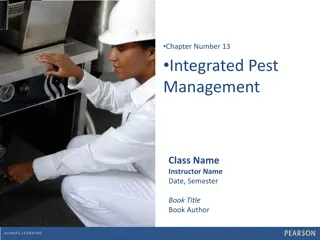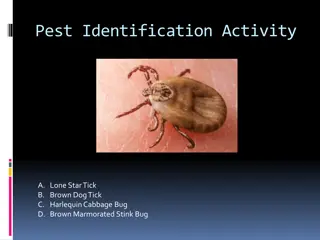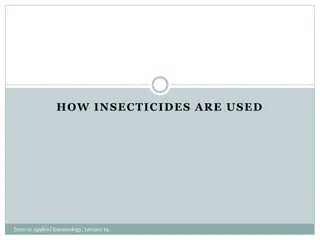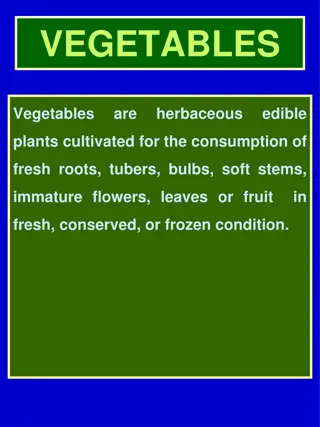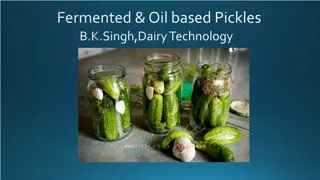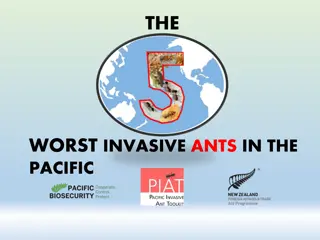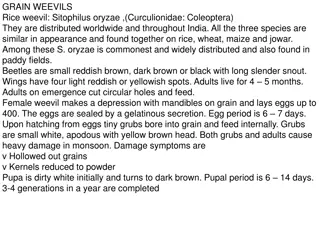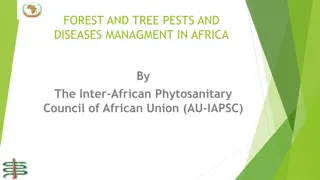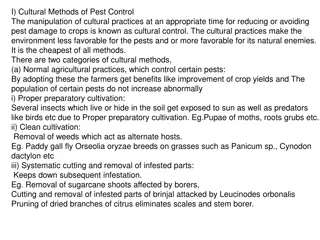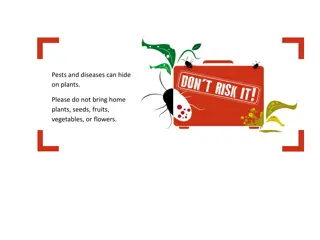Common Diseases and Pests Affecting Vegetables in Agriculture
Various diseases and pests pose threats to vegetable crops, causing economic losses. Control strategies involve both chemical and mechanical methods. Common diseases discussed include Clubroot, Downy Mildew, Sclerotinia Stem Rot, and Anthracnose, each with distinctive symptoms and management practices to mitigate their impact on vegetable cultivation.
Download Presentation

Please find below an Image/Link to download the presentation.
The content on the website is provided AS IS for your information and personal use only. It may not be sold, licensed, or shared on other websites without obtaining consent from the author. Download presentation by click this link. If you encounter any issues during the download, it is possible that the publisher has removed the file from their server.
E N D
Presentation Transcript
NORTH WEST DEPARTMENT OF AGRICULTURE AND RURAL DEVELOPMENT AGRICULTURAL SUPPORT SERVICES Presentation title: Common diseases and pests affecting Vegetables M. Mtileni Crop Science Research and Technology Development Dr KK District Presenter s contact details: mmtileni@nwpg.gov.za 018 299 6503/072 266 4276 Date: August 2021
Introduction Various diseases and pests attack vegetables, and this can lead to serious economic loss. Generally speaking, pest management strategies, chemical and mechanical control of pests and diseases can be used for control.
Diseases affecting Vegetables 1. Clubroot (Plasmodiophora brassicae) Symptoms Slow growing, stunted plants; yellowish leaves which wilt during day and rejuvenate in part at night; swollen, distorted roots; extensive gall formation. fungus can survive in soil for periods in excess of 10 years; can be spread by movement of contaminated soil and irrigation water to uninfected areas. Management Once the pathogen is present in the soil it can survive for many years, elimination of the pathogen is economically unfeasible; rotating crops generally does not provide effective control. Plant only certified seed and avoid field grown transplants unless produced in a fumigated bed; applying lime to the soil can reduce fungus sporulation.
2. Downy mildew (Peronospora parasitica) Symptoms Small angular lesions on upper surface of leaves which enlarge into orange or yellow necrotic patches; white fluffy growth on undersides of leaves. Disease emergence favored by cool, moist conditions. Management Remove all crop debris after harvest; rotate with non-brassicas. It is possible to control downy mildew with the application of an appropriate fungicide.
3. Sclerotinia stem rot (White mold) Sclerotinia sclerotiorum Symptoms Irregular, necrotic gray lesions on leaves; white-gray leions on stems; reduced pod set; shattering seed pods. Disease emergence favours moderate to cool temperatures and high humidity. Management Rotate crop to non-hosts (e.g. cereals) for at least 3 years; control weeds; avoid dense growth by planting in adequately spaced rows; apply appropriate foliar fungicides.
4. Anthracnose (Shot-hole) Microdochium panattonianum Symptoms Small water-soaked tan spots on outer leaves which may expand and turn straw colored; centers fall out of mature lesions giving plant a shot-hole appearance. Fungus survives in crop debris in soil; disease spread by splashing water Management Rotate crops; plow crop debris into soil; control wold lettuce populations around plantation; avoid overhead irrigation
5. Leaf drop (Sclerotinia drop) Sclerotinia minor, Sclerotininia sclerotiorum Symptoms Wilting of outside leaves which spread inwards until whole plant is affected; soft watery lesions on leaves; leaves collapse and lie on soil surface. Black fungal structures on infected leaf tissue and soil surface. This fungi can survive in soil for 8-10 years. Management Disease significantly reduced by application of fungicides immediately after thinning plants; Plow soil deeply; rotate crops with non-hosts
6. Septoria leaf spot Septoria lactucae Symptoms Small, irregularly shaped chlorotic spots on oldest plant leaves which enlarge and turn brown and dry out; lesions may fall out of leaves creating holes; leaf spots may have chlorotic halos. if plant is severely infected, lesions may coalesce forming large necrotic patches, wilting leaves and plant death. Fungus survives in infected seed and in crop debris; disease spreads in humid or wet conditions; can be spread by splashing water; weeds are an important overwintering site for the fungus. Management Plant pathogen free seed; plant in areas where Septoria is uncommon; ideal planting sites are in regions with low rainfall; hot water treatment of seeds prior to planting may help reduce levels of disease.
Pests affecting Vegetables 1. Beet armyworm Spodoptera exigua Symptoms Singular, or closely grouped circular to irregularly shaped holes in foliage; heavy feeding by young larvae leads to skeletonized leaves; shallow, dry wounds on fruit. egg clusters of 50-150 eggs may be present on the leaves; egg clusters are covered in a whitish scale which gives the cluster a cottony or fuzzy appearance. young larvae are pale green to yellow in color while older larvae are generally darker green with a dark and light line running along the side of their body and a pink or yellow underside. Insect can go through 3 5 generations a year. Management Organic methods of controlling the beet armyworm include biological control by natural enemies which parasitize the larvae and the application of Bacillus thuringiensis. chemicals control is also recommended.
2.Cabbage aphid Brevicoryne brassicaea Symptoms Large populations can cause stunted growth or even plant death; insects may be visible on the plant leaves and are small, grey-green in color and soft bodied and are covered with a white waxy coating; prefer to feed deep down in cabbage head and may be obscured by the leaves. Cabbage aphids feed only on cruciferous plants but may survive on related weed species. Management If aphid population is limited to just a few leaves or shoots then the infestation can be pruned out to provide control; check transplants for aphids before planting; use tolerant varieties if available; reflective mulches such as silver collared plastic can deter aphids from feeding on plants; sturdy plants can be sprayed with a strong jet of water to knock aphids from leaves. Insecticides are generally only required to treat aphids if the infestation is very high - plants generally tolerate low and medium level infestation; insecticidal soaps or oils such as neem or canola oil are usually the best method of control; always check the labels of the products.
3.Cabbage looper Trichoplusiani Symptoms Large or small holes in leaves; damage often extensive; caterpillars are pale green with a white lines running down either side of their body. Caterpillars are easily distinguished by the way they arch their body when moving; eggs are laid singly, usually on the lower leaf surface close to the leaf margin, and are white or pale green in colour. Cabbage looper can be identified by their characteristic "looping" movement in which they arch their body and bring the back portion of the body forward to meet the front. Management Looper populations are usually held in check by natural enemies; if they do become problematic larvae can be hand-picked from the plants; biological controls such as spraying with Bacillus thuringiensis can be effective at controlling looper numbers. Application of appropriate insecticide also controls looper populations; selective insecticides help to protect populations of natural enemies on crop.
4.Diamondback moth Plutella xylostella Symptoms Young larvae feed between upper and lower leaf surface and may be visible when they emerge from small holes on the underside of the leaf; older larvae leave large, irregularly shaped shotholes on leaf undersides, may leave the upper surface intact; larvae may drop from the plant on silk threads if the leaf is disturbed; larvae are small (1 cm/0.3 in) and tapered at both ends. Larvae have to prolegs at the rear end that are arranged in a distinctive V-shape. Larvae take between 10 and 14 days to mature and spin a loose, gauze-like cocoon on leaves or stems to pupate. Management Larvae can be controlled organically by applications of Bacillus thurengiensis. Application of appropriate chemical insecticide is only necessary if larvae are damaging the growing tips of the plants
Cabbage looper Trichoplusiani Symptoms Large or small holes in leaves; damage often extensive; caterpillars are pale green with a white lines running down either side of their body; caterpillars are easily distinguished by the way they arch their body when moving; eggs are laid singly, usually on the lower leaf surface close to the leaf margin, and are white or pale green in colour. Cabbage looper can be identified by their characteristic "looping" movement in which they arch their body and bring the back portion of the body forward to meet the front. Management Looper populations are usually held in check by natural enemies; if they do become problematic larvae can be hand-picked from the plants; biological controls such as spraying with Bacillus thuringiensis can be effective at controlling looper numbers. Application of appropriate insecticide also controls looper populations; selective insecticides help to protect populations of natural enemies on crop.



